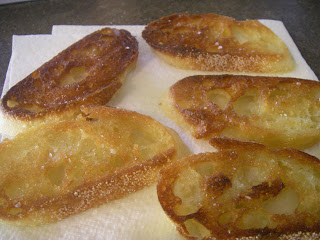It's the new rage. It's delicious. And unless you live next to a fantastic patisserie, you probably can't find a good one. There are recipes all over the blogs, and I am here to provide you with yet
another method to help you figure out this little bit of cookie madness! The ingredients are pretty much always the same, in similar proportions, with similar methods...but it seems that everyone has their own little twist...
A macaron is a traditional French cookie made popular by Pierre Herme, a seriously famous pastry chef in Paris that deserves every bit of his acclaim. The outer shell is essentially a meringue enriched with almond flour. It is often colored to give a hint of what the filling is. Fillings range in every flavor from fruit preserves to flavored ganache. My most successful fillings so far are Meyer lemon curd and white chocolate-lavender.
Macarons (yield 36 sandwiches)
Before you start, make sure that you have ready four regular sized cookie sheets lined with parchment or (preferably) Silpat baking mats, an accurate candy thermometer, and a piping bag fitted with a medium round tip. Also, this recipe is a prime example of the need to have your
mise en place organized and ready to go prior to embarking on your macaron journey.
Step 1:
150 g almond flour (you can grind blanched slivered almonds in a coffee grinder and sift through a very fine sieve)
150 g confectioners sugar (sifted, unless you are grinding your own almonds, in which case you should grind some of the sugar with the nuts to keep them from caking)
Sift these two ingredients well, and set aside combined.
Step 2:
100 g egg whites (aged at least 24 hours and up to 48 hours at room temperature- they won't spoil)
35 g granulated sugar
In a very clean mixing bowl, start beating the whites on low speed until frothy, then slowly add the sugar and whip until soft peaks form
.
Step 3:
150 g granulated sugar
50 g water
While your meringue is whipping, heat the sugar and water to 110C/230F. This will be just a few moments after the mixture turns completely clear. It is very important to have the whites at soft peaks when the mixture reaches temperature because if you heat the sugar too long, it will create too firm of a meringue. With the mixer running on low speed, gently drizzle in the hot syrup, then bring the speed up to medium and whip until cooled a bit and the meringue holds a good shape, at least thirty seconds. For those of you new to meringues, this is considered an Italian meringue.
Step 4:
Fold the almond flour and confectioners sugar into the meringue. If you wish to add any colorings, now would be the time to do it. Continue to fold until the mixture is homogeneous and the texture is such that any distinct shapes melt into the batter in 30 seconds. If the meringue is too firm, the cookies will come out more button shaped, and if the meringue is too thin, well, just make sure you don't over mix it or you will end up with sweet crackers. Many recipes describe this as the consistency of "magma," if this helps you, great, but I didn't have any magma around to compare with.
Step 5:
Immediately, put batter into piping bag and pipe quarter sized disks onto the baking sheets, leaving about 1/2" between each one. They don't expand much, but they do need room for the air to circulate around. After piping, set them in a safe place for at least one half but up to two hours so they can form a kind of shell. When you are ready to bake, preheat your oven to 310F for convection, 330F without. This is where your intimate relationship with your oven gauge comes in handy, because every oven is just a little different, and it may take a few tries to get the baking bit just right. Once in the oven, bake for five minutes, then rotate and bake for perhaps two minutes more. Remove from the oven, let cool for a couple of minute on the Silpats/parchment, and then gently place them on cooling racks to finish. Once they're cool, fill with whatever suits your fancy- buttercream, ganache, jam, nut pastes.



































